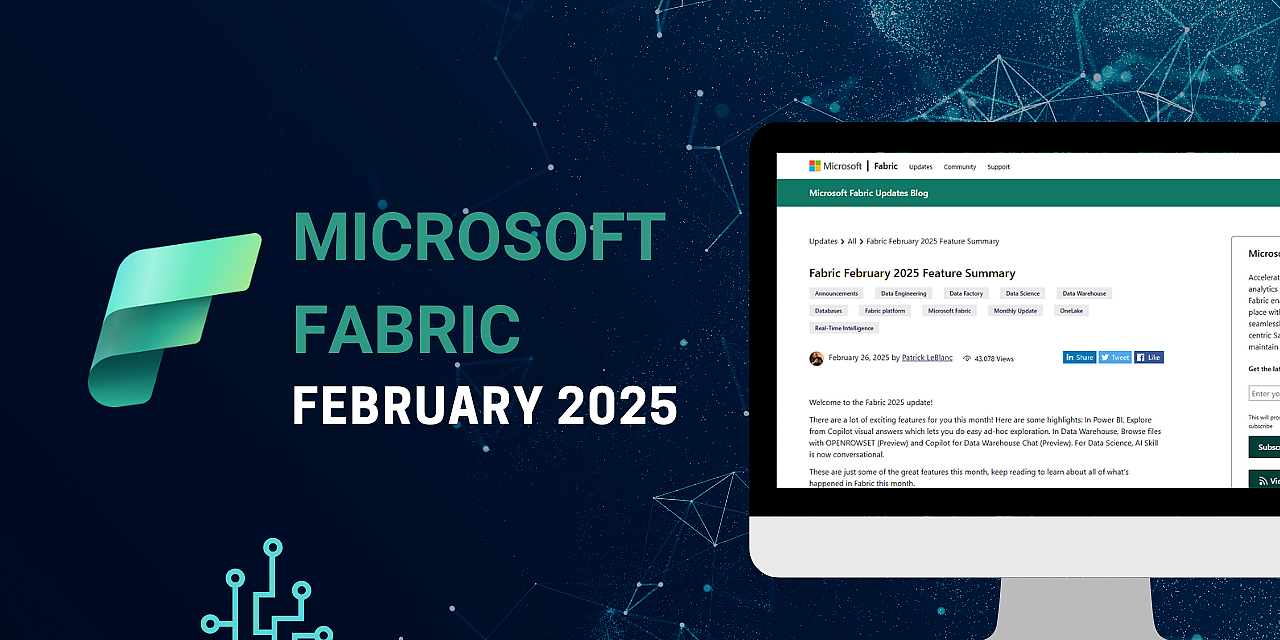Microsoft Fabric Updates February 2025
B2 BI brings you the latest updates from Microsoft Fabric

With carefully designed reports, you can get complete insight into your business data with just a few visualizations.
B2 BI brings you the latest updates from Microsoft Fabric, focusing on advancements in Power BI, data engineering, and data warehousing. Here’s what’s new this month:
Power BI
Data Engineering
Data Warehouse
Databases
Power BI
OneLake Catalog in Microsoft Teams
The OneLake catalog is now integrated within the Power BI app experience in Microsoft Teams. This integration enables users to seamlessly explore and interact with their data within the Microsoft Office ecosystem, streamlining workflows without leaving Teams.
Data Engineering
T-SQL Notebook Enhancements
Several improvements have been made to T-SQL Notebook, including:
-
Additional T-SQL code snippets.
-
The ability to open full datasets in Excel.
-
Primary warehouse traceability.
-
Full CI/CD support, including Git integration and deployment pipelines.
A new T-SQL code snippet library has been added, offering templates for:
-
Data ingestion: COPY INTO, CREATE TABLE AS SELECT, INSERT INTO.
-
Business continuity: Cloning tables at specific points in time.
-
Development: Creating schemas, views, stored procedures, and statistics.
-
Monitoring: Query history, session activity, and performance metrics.
Users can now open query results directly in Excel with a single click. Additionally, the primary warehouse for each notebook session is now trackable, improving auditability and consistency in query execution.
CI/CD Support for T-SQL Notebook
T-SQL Notebooks now offer full Git and Deployment Pipeline support. Users can commit code changes and bindings to a Git repository for version control and history tracking. The deployment pipeline allows seamless transitions across different workspaces.
Fabric Spark Resource Analysis (General Availability)
The Fabric Spark Resource Utilization Analysis feature is now generally available. This tool provides real-time insights into Apache Spark applications running within Microsoft Fabric, identifying potential bottlenecks and optimizing resource allocation. Key features include:
-
Real-time monitoring of running, idled, and allocated executor cores.
-
Interactive visualization of resource allocation.
-
Detailed performance breakdowns for executor and job analysis.
This feature supports Spark runtime version 3.4 and above.
Data Warehouse
Copilot for Data Warehouse Chat (Preview)
The Copilot chat experience for Data Warehouse is now in preview. Users can interact with Copilot using natural language to perform tasks such as:
-
Generating SQL queries from plain text.
-
Asking for query performance insights.
-
Managing table relationships and security settings.
OPENROWSET for File Browsing (Preview)
The OPENROWSET function is now available, allowing users to query parquet and CSV files directly from Fabric Data Warehouse and SQL endpoints. This feature supports:
-
Ad-hoc file browsing without ingestion.
-
Schema exploration before ETL/ELT processes.
-
Error analysis for rejected data rows.
Example usage:
SELECT TOP 10 *
FROM OPENROWSET(BULK 'https://path-to-file.parquet') AS r
The function supports schema inference and explicit schema definitions for structured data retrieval.
BULK INSERT for Data Loading (Preview)
Fabric Data Warehouse now supports BULK INSERT, allowing users to load CSV files from Azure Data Lake Storage (ADLS). This provides an alternative to COPY INTO, offering familiar syntax for users migrating from SQL Server. Key features include:
-
Row and field terminator customization
-
Compatibility with existing SQL Server codebases
-
Support for non-Unicode file sources
Example usage:
BULK INSERT ecdc_cases
FROM 'https://path-to-file.csv'
WITH (FIRSTROW = 2, FIELDTERMINATOR = ',', ROWTERMINATOR = '\n');
Nested Common Table Expressions (General Availability)
Microsoft Fabric Data Warehouse now fully supports nested Common Table Expressions (CTEs), allowing users to simplify complex queries into structured, readable blocks. Available CTE types include:
-
Standard CTE: Independent CTE definitions.
-
Sequential CTE: References previous CTEs but does not define new ones.
-
Nested CTE: Supports defining new CTEs within existing ones.
Databases
Performance Dashboard in SQL Database
A new Performance Dashboard is available in Microsoft Fabric SQL databases, providing diagnostic tools to identify and resolve performance bottlenecks. The dashboard includes:
-
CPU consumption analysis.
-
User connection monitoring.
-
Requests-per-second tracking.
-
Automatic indexing for performance optimization.
This update enhances database administrators’ ability to monitor, troubleshoot, and optimize SQL workloads within Microsoft Fabric.
Read more on Microsoft blog.
These updates continue to enhance Microsoft Fabric’s capabilities, making it a more powerful platform for data engineering, analytics, and business intelligence. Stay tuned for more insights from B2 BI on how these features can be leveraged to optimize your data-driven decision-making processes.
